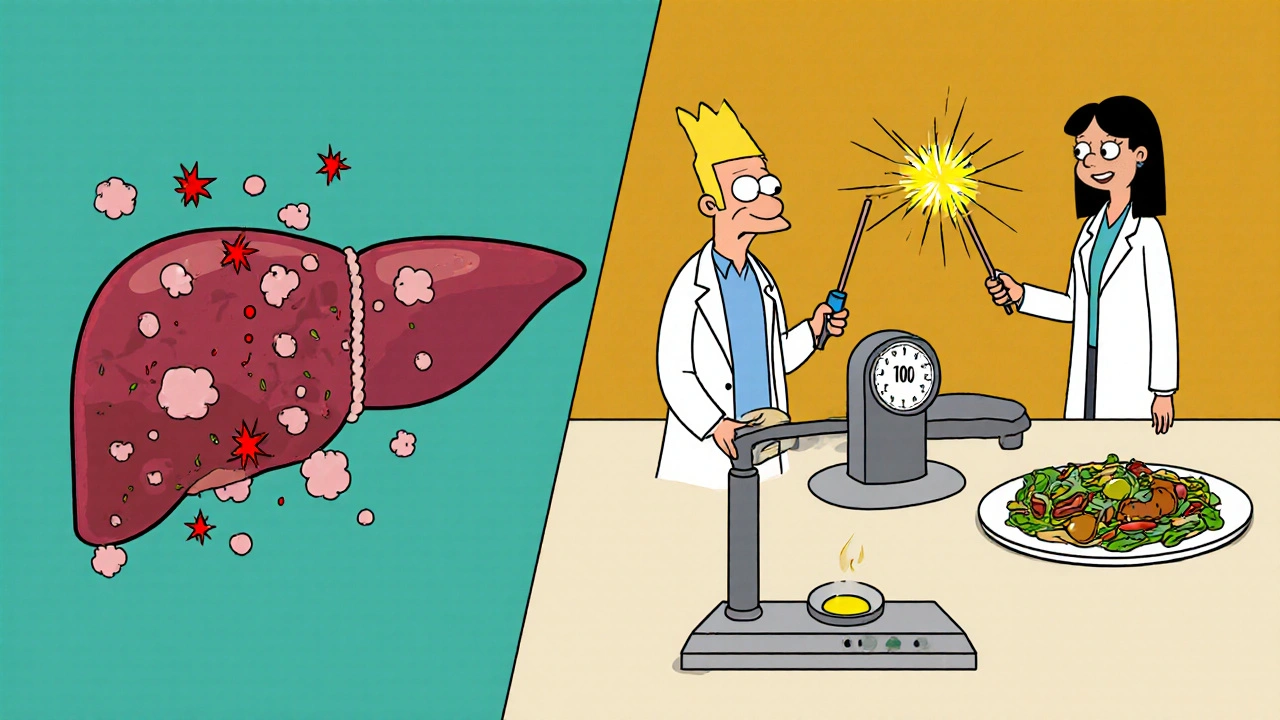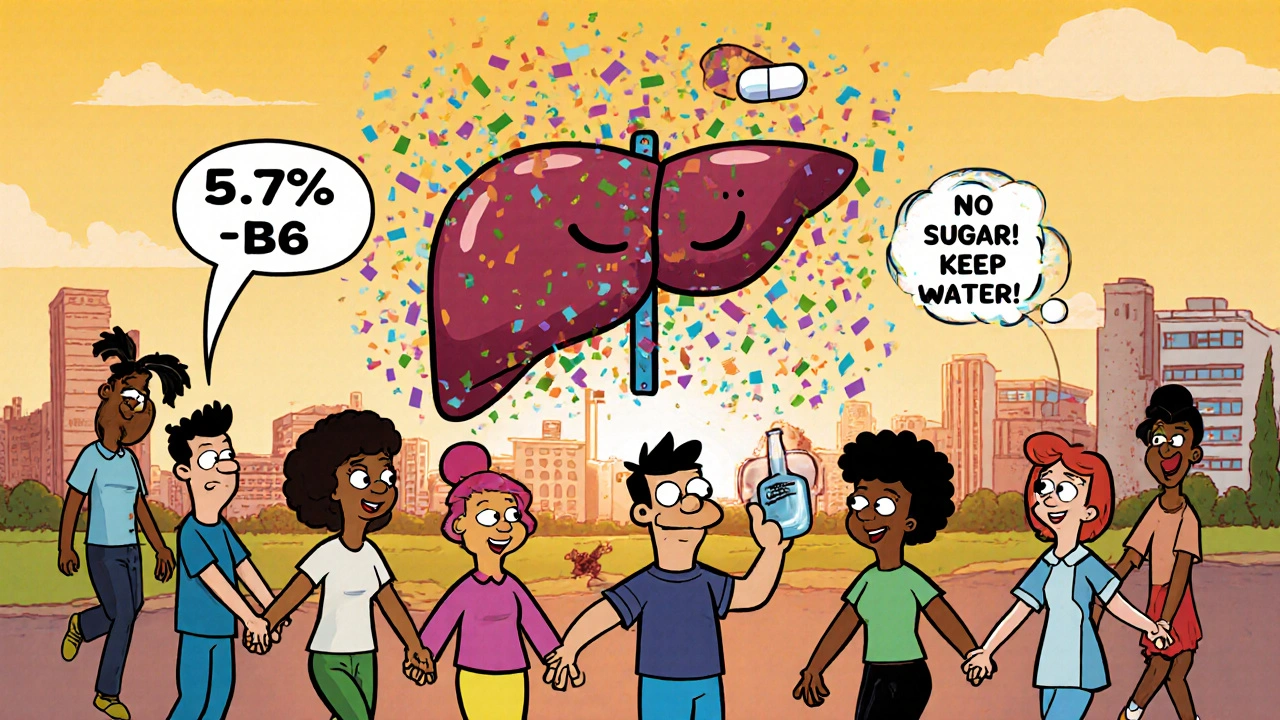Metabolic-Associated Fatty Liver: How Weight Loss and GLP-1 Drugs Work Together

More than one in four adults worldwide has fat building up in their liver-not from drinking alcohol, but from how they eat, move, and live. This isn’t just about being overweight. It’s a metabolic problem called MASLD (Metabolic Dysfunction-Associated Steatotic Liver Disease), the new name for what used to be called NAFLD. The change wasn’t just semantic. It meant doctors now look for metabolic signs-like high blood sugar, belly fat, or high triglycerides-to diagnose it, not just rule out other causes. And if you’ve been told you have fatty liver, the good news is: it can get better. The best way? Losing weight. The newer tool? GLP-1 receptor agonists. Together, they’re changing how this condition is managed.
What Really Causes Fat to Build Up in Your Liver?
Your liver doesn’t store fat by accident. When your body becomes resistant to insulin-often because of excess belly fat-your fat cells start leaking free fatty acids into your bloodstream. About 59% of the fat that piles up in your liver comes from this overflow. Another 26% is made right inside your liver from the carbs you eat, especially sugar and refined grains. Your liver also gets worse at burning fat for energy and shipping it out as usable fuel. It’s a perfect storm: too much input, not enough output.
This isn’t just about fat sitting there. When fat builds up, it triggers inflammation, oxidative stress, and cell damage. That’s when simple fatty liver turns into MASH-Metabolic Dysfunction-Associated Steatohepatitis. That’s the version that can lead to scarring, cirrhosis, or even liver cancer. The scary part? About 20% of people with obesity develop MASH. And once fibrosis sets in, it’s harder to reverse.
Weight Loss Isn’t Just Helpful-It’s the Gold Standard
If you do nothing else, losing weight is the most powerful thing you can do for your liver. But not just any weight loss. Research shows clear thresholds:
- 5-7% body weight loss → reduces liver fat
- 10% or more → reduces inflammation and fibrosis; can even reverse MASH
The Look AHEAD trial found that people who lost 10% of their body weight cut their risk of developing MASH by 90%. That’s not a small effect. It’s life-changing. How does it work? Losing weight cuts the flow of fatty acids from your belly fat to your liver by 30-40%. It also slows down the liver’s own fat-making process by 25-35% and helps your mitochondria burn fat more efficiently.
The European Association for the Study of the Liver recommends aiming for 7-10% weight loss over 6-12 months. That means eating 1,200-1,800 calories a day (depending on your size), moving 150-300 minutes a week, and focusing on whole foods-not calorie counting alone. Mediterranean-style diets, low in added sugar and fructose, show the best results.
GLP-1 Drugs: A Game Changer for Liver Fat
For many people, losing 10% of their body weight through diet and exercise alone is extremely hard. That’s where GLP-1 receptor agonists come in. These drugs-like semaglutide (Wegovy, Ozempic) and liraglutide (Saxenda)-were originally designed for type 2 diabetes and obesity. But their effect on the liver is just as powerful.
In the STEP-1 trial, people taking semaglutide 2.4 mg lost an average of 15% of their body weight. Post-hoc analysis showed a 55% drop in liver fat measured by MRI. In the REGENERATE trial, semaglutide 1.0 mg led to MASH resolution in 52% of patients-nearly double the placebo group. Liraglutide did something similar: 39% of users saw MASH resolve, compared to just 17% on placebo.
How do they work? GLP-1 drugs don’t just make you feel full. They improve insulin sensitivity in fat tissue, so less fat leaks into the liver. They turn down the liver’s fat-making machinery by activating AMPK. And they reduce inflammation by blocking NF-κB, a key driver of liver damage. It’s a three-pronged attack on the root causes of MASLD.

But It’s Not Perfect-Side Effects and Real-World Challenges
These drugs work well-but they’re not easy to take for everyone. In Reddit’s r/fattyLiver community, 76% of users reported nausea. Nearly one-third quit within six months because of stomach upset, vomiting, or diarrhea. That’s a huge dropout rate. And it’s not just discomfort. Some people experience dizziness, constipation, or fatigue.
Another issue? Weight regain. On the American Liver Foundation forum, 68% of people who lost 10% of their weight couldn’t keep it off past 12 months. Many regained more than half of it within two years. That’s why GLP-1 drugs are best used as part of a plan-not a quick fix. When paired with diet counseling, adherence jumps from 42% to 65% after one year.
And while these drugs help with fat and inflammation, they’re less effective for advanced scarring (F3-F4 fibrosis). That’s where newer drugs like resmetirom (expected FDA approval in early 2024) may come in-used in combination with GLP-1 therapy.
What Does a Real Treatment Plan Look Like?
Top liver clinics like Duke University don’t just hand out prescriptions. They follow a structured protocol:
- Start with a FibroScan and MRI-PDFF to measure liver fat and stiffness
- Calculate your FIB-4 score to estimate fibrosis risk
- Begin GLP-1 therapy at a low dose (0.25 mg/week), slowly increasing over 16-20 weeks
- Meet with a dietitian twice a week for the first three months-focus on Mediterranean diet, under 25g fructose/day
- Do 150 minutes of moderate exercise weekly (brisk walking, cycling, swimming)
- Monitor for nausea: many clinics add pyridoxine (vitamin B6) 25 mg twice daily to help
Meal replacement programs-like shakes or bars-help with adherence. People using them stick to the plan 78% of the time, compared to 52% with standard advice. It’s not about perfection. It’s about consistency.

Cost, Access, and the Future
Semaglutide costs about $1,350 a month. Liraglutide is close behind at $1,250. Medicare covers it for obesity in about two-thirds of cases, but private insurance varies. Many patients pay out of pocket-unless they have diabetes, which makes coverage easier.
The market is exploding. Global spending on MASLD treatments hit $14.8 billion in 2023 and could hit $28.7 billion by 2030. Semaglutide leads the pack, but tirzepatide (Mounjaro) is coming fast-showing even greater weight loss in trials.
And the future? By 2030, MASLD is expected to become the top reason for liver transplants in the U.S., surpassing hepatitis C. That’s why research is accelerating. The FDA now accepts MRI-PDFF and FibroScan results as official endpoints in drug trials, which speeds up approval of new therapies.
But access remains uneven. While 72% of U.S. academic medical centers now have MASLD clinics, only 28% of rural counties with under 50,000 people have any specialist at all. If you’re outside a major city, finding care can be a challenge.
What Should You Do If You Have MASLD?
Start with the basics: lose 5-7% of your weight. Eat more vegetables, lean protein, and healthy fats. Cut out sugary drinks and processed snacks. Walk every day. That alone can improve your liver.
If you’ve tried and struggled, talk to your doctor about GLP-1 agonists. Don’t assume they’re only for diabetes or extreme obesity. They’re now a standard option for anyone with MASLD and metabolic dysfunction.
And if you’re on one of these drugs? Don’t give up if you feel sick at first. Many side effects fade after 4-6 weeks. Ask about B6 supplements. Work with a dietitian. Stay connected with support groups. This isn’t a sprint. It’s a long-term reset of your metabolism.
The liver is resilient. Even if you’ve had fat in your liver for years, the damage isn’t always permanent. With the right combination of weight loss and targeted therapy, many people see their liver fat drop, inflammation vanish, and fibrosis stabilize. It’s not magic. It’s science. And it’s working-for thousands of people right now.
Can you reverse fatty liver without losing weight?
No-not reliably. While cutting out alcohol, sugar, and processed foods helps, studies show that without meaningful weight loss (at least 5-7% of body weight), liver fat doesn’t significantly decrease. GLP-1 drugs work because they help you lose weight. Lifestyle changes alone can work, but only if they lead to sustained weight reduction. There’s no shortcut.
Do GLP-1 drugs work for everyone with fatty liver?
They work best for people with metabolic dysfunction-obesity, type 2 diabetes, high blood pressure, or high triglycerides. If you have MASLD but no metabolic issues, GLP-1 drugs aren’t recommended. Also, they’re less effective if you already have advanced scarring (F3-F4 fibrosis). In those cases, combination therapy with drugs like resmetirom may be needed.
How long do you need to stay on GLP-1 drugs for fatty liver?
There’s no fixed timeline. Most people stay on them long-term because weight and liver fat rebound when you stop. Think of it like blood pressure or cholesterol medication-you take it to maintain the benefit. Some people eventually wean off after sustained weight loss and lifestyle changes, but that’s rare without continued support. Stopping often leads to a return of liver fat within months.
Is a liver biopsy necessary to diagnose MASLD?
No. Most doctors use non-invasive tools first: FibroScan (to measure fat and stiffness), MRI-PDFF (to quantify fat), and blood tests like FIB-4 or APRI to estimate scarring. A biopsy is only done if results are unclear or if there’s concern about advanced disease. The trend is moving away from biopsies toward imaging and blood markers.
Can you use GLP-1 drugs if you don’t have diabetes?
Yes. Semaglutide (Wegovy) and liraglutide (Saxenda) are FDA-approved specifically for chronic weight management in people without diabetes. Their benefit for MASLD doesn’t require a diabetes diagnosis-only metabolic dysfunction, like obesity or high blood sugar. Many patients without diabetes use them for liver health.